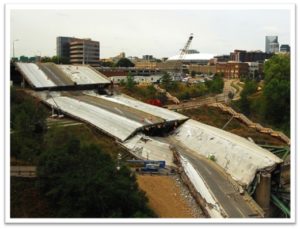As I discussed in an earlier post, there’s a growing local and national backlog of critical transportation infrastructure projects—with no funding in sight.
Consensus Actually Exists
You might be interested to know that all branches of the federal government, from both sides of the isle, agree that we are not investing properly now for the transportation needs of the future.
To put this in perspective, the U.S. is spending approximately 4 to 5 times less on infrastructure than other countries are, including developing nations like China and India.
Since our interstate highway system was built in the 1960s, government expenditures on infrastructure have fallen to just 2.4 percent of GDP. In contrast Europe invests 5 percent of its GDP on infrastructure and China 9 percent.
 As a result, the United States Is now ranked twenty-third overall for infrastructure quality, between Spain and Chile.
As a result, the United States Is now ranked twenty-third overall for infrastructure quality, between Spain and Chile.
Political Will Does Not
Not so long ago, spending tax dollars on infrastructure was not nearly so political and divisive as it is today. Roads, bridges and railways used to be neutral ground on which the parties could come together to support the country’s growth. In 1991, the federal transportation bill (the Intermodal Surface Transportation Efficiency Act, termed ISTEA for short), passed both branches of Congress by nearly a 5 to 1 margin.
Fast forward twenty years.
 Today’s gridlock in Washington has resulted in years of legislative limbo. Transportation funding has been limping along under a series of short-term extensions and appropriations because Congress can’t agree on what should be included in the new transportation bill—and hasn’t figured out how to pay for them either.
Today’s gridlock in Washington has resulted in years of legislative limbo. Transportation funding has been limping along under a series of short-term extensions and appropriations because Congress can’t agree on what should be included in the new transportation bill—and hasn’t figured out how to pay for them either.
The consequences of this inaction are severe. Crumbling bridges and roadways and increased congestion will not only be expensive problems to solve in the future, but will also have a cost in the increased amount of time we spend on substandard roads.
Our nation’s economic future relies on its ability to deliver goods and services, a task that is increasingly more difficult as our highway system falls into disrepair. Without action, our nation’s economic competitiveness will diminish.
While the urgency of the problem is plain to all – the political will to fix it isn’t there.
It Will Get Personal
And the hard part is, it’s not just our politicians who will need to make some attitude adjustments. All of us, as users of the transportation network, will need to be willing to make a shift in how we think about paying our way.
Mileage-based fees, not motor fuel taxes, are the fairest way to assess the costs and benefits to the users of the system. BUT…
Solutions Exist
There are many options, ideas and technologies available to us to pay for the transportation system we need, now and into the future.
But they will take some getting used to. I’ll talk about them in my next blog post. Stay tuned.
Pothole photo credit: David Erickson I-35 photo credit: Marion Doss

